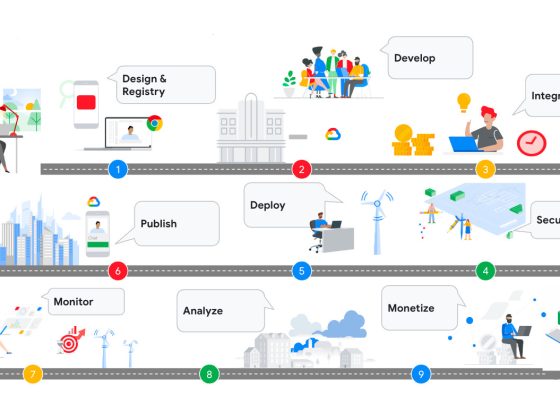Guest post by Anind Mathur and Akash Bakshi of MSys Technologies
As we hopefully look forward to what can be a better year, MSys Technologies brings you the 2021 tech predictions based on our Software Product Engineering Services and Digital Transformation expertise.
From our partners:
Software Product Engineering
Momentum for Single Data Platform with Low Code/No Code
1.1 Single Data Platform and Low Code/No Code to be Preferred Choice
In 2021, we will see one single Data Platform for business use cases. Also, the Low Code/ No Code will become the norm in the product engineering field. Whether enterprises need to fill developer gaps or reduce development time, single low-code platforms will be a popular and easy-to-use solution. It will be of great help and game-changer for several organizations.
1.2 Modern Programming Languages to Emerge as Frontrunners
Backed by the Tech giants, expect modern programming languages to gain more traction, popularity, and usage in 2021. Companies will look forward to using modern programming languages instead of traditional ones like C/C++ for more security-sensitive and complex projects.
1.3 Client-Side and Server-Side Web Frameworks – Convergence
In 2021, all the major JavaScript/TypeScript based client-side frameworks such as React, Vue.js, and Svelte shall cross-pollinate for improved usability. Also, ASP.NET Core will be a significant player in Server-Side development for enterprises. Several small companies and start-ups want to have an end-to-end framework, including the View layer, for rapid application development. PHP Laravel, Python-based Django, and Ruby on Rails will be great options for them in 2021.
1.4 Cross-Platform Development to Compete with Native App Development
Though Native app development is still the better choice for enterprises, cross-platform app development is catching up. In 2021, larger enterprises will favor Native app development; however, small companies and start-ups will favor cross-platform app development.
1.5 REST API for Business Applications
REST API will continue to dominate API technology in 2021. Software or App developers can now develop sophisticated Cross-platform or native apps using REST API.
Cloud Engineering
Code-First To Take Over Open Networks, Cybersecurity Remains Top Priority
2.1 Code-first open network architecture
In 2021, the Code-First model will take over the entire open network architecture, focusing on the domain of the application. It will start generating classes for the domain entity instead of designing the database first and then creating the classes that match the database design. This code first open network architecture, will ensure an efficient flow of information, and control data up and down the organization seamlessly.
2.2 Edge Computing and 5G to Gain Ground Value
2021 is the year edge computing will finally become a real value. In 2021, new business models will evolve to promote the deployment of “edge” in production. Cloud platforms needing to compete with artificial intelligence and the extensive proliferation of 5G will make edge use cases much more practical.
2.3 Automated Governance and Heightened Cybersecurity
With the heightened awareness of governance and cybersecurity in 2021, an open governance and security automation framework will help build code to minimize human error. This will allow cybersecurity professionals to develop structured workflows that can be integrated into existing SOAR platforms and SIEM applications, ensuring that security strategies are aligned with business objectives and consistent with regulations.
Automation combined with open-source tools is the key to a code-first model, edge computing, and robust cybersecurity.
DevOps
Uprising of BizDevOps and Auto-Pilot mode in DevOps Automation
3.1 Automated Code Analysis
In 2021, we will see an uprising of automated codes to identify the release cycle challenges as early as possible. Static and dynamic code analysis tools will help enterprises ship code that is more stable and faster, and minimize production challenges.
3.2 DataOps Will Grow
2021 will be a high time when DevOps will start using available data and metrics to generate valuable insights. Such foresight would predict incidents or outages, develop automation, and forecast capacity to improve budget planning.
3.3 DevOps Becomes BizDevOps
2021 will see a constant rise of BizDevOps being widely adopted by enterprises aiming to be more focused, agile, and flexible. This is due to the existing pandemic situation and the necessity to transform into full digitalization. With the right BizDevOps tools, enterprises will have the power to streamline their business innovation process while minimizing the risk of uncertainty.
3.4 The Evolution of GitOps
GitOps signifies how DevOps apply developer tooling to drive operations. In 2021, GitOps will speed up development to make changes and updates securely into complex applications running in Kubernetes.
3.5 Autonomous DevOps Automation and Chaos Engineering
DevOps will now slowly move towards autonomous and advanced techniques that help in activities within the lifecycle and automated outputs across all the stages. The ecosystem will include robotic process automation tools to help automate manual tasks for better productivity. Also, chaos engineering is all set to become an extremely critical aspect of today’s hybrid infra world. In 2021, it will be used more and more to boost confidence in the system’s ability to withstand turbulent and uncertain outages.
3.6 Serverless Architecture Is on The Rise
Another pattern that will revolutionize DevOps in 2021 is the application of serverless architecture. With serverless, enterprises can overcome any barrier amongst operations and development. This could help further in enabling operability and achieving business agility while minimizing costs.
3.7 Emergence of NoOps and DevSecOps
2021 will see more and more managed services emerging to minimize DevOps operations and reduce OPEX in customers. Also, the “Sec” part of DevSecOps will become an integral part of the SDLC. Customers will be delivered with practical security solutions to optimize software functioning.
Automation blended with code analysis, GitOps, DataOps, DevSecOps, NoOps, and serverless architecture will enable BizDevOps and chaos engineering. This will help drive tangible business results for enterprises worldwide.
Storage Engineering
Smart and Secure Storage with Artificial Intelligence, powered by NVMe
4.1 AI and Storage Conflation
In terms of performance, this is a good year for AI and Storage cooperation. Rising Artificial computing (AI) applications indicate a boost in accelerated compute servers, specialized processors. This is good news for smart NICs and data processing units (DPUs) as processor CPUs heavily rely on them for data center efficiency and flexibility.
4.2 Containers to see an increased application in Storage
Container-based services will handle scalability and Agility for storage solutions. Container-centric transactional databases, backup, and archives, logs, among others, will outdo their traditional counterparts owing to the unequivocal popularity of Kubernetes.
4.3 Wireless Innovation to Boost IoT and Storage Integration
2021 is also a good year for exploring better wireless innovations. This is good news for cloud storage services. With better wireless connectivity options, organizations could easily integrate IoT technologies and cloud storage and processing solution with their on-premise storage ecosystems.
4.4 Newer Security Measures to Grace Data Storage
The hyper-scale software ecosystems will also be strengthened by security measures like hierarchical data security and data-at-rest encryption algorithms. Owing to the rise in mobile access for data in 2020, Storage tiering and active archives will make more sense from a security perspective. This also paves the way for service-mesh based secure networks to enable more remote connectivity with on-premise core-data centers.
4.5 NVMes to Continue their Impressive Run Rate
With their support for Remote Direct Memory Access, RDMA, NVMe based storage solutions are going to thrive this year as well. With the advances in SSD storage and PCIe buses, NVMe will maintain a prominent storage landscape presence. NVMe’s support for Computational storage drives, CXL interface, and ASIC processors will make it an essential player in integrating Storage and Artificial intelligence innovations.
Thus, while the organizations explore artificial Intelligence-based Data Lakes and Data Warehouses, container-based infrastructures and cloud storage innovations would be indispensable in the near future. NVMes-based solutions would be a preferred choice when it comes to hardware, and advanced security measures would be welcomed to build a competitive data storage advantage.
UI/UX
Advanced Micro-interaction and Super Apps to drive Digital World
5.1 Software driven Behavioral Research
2021 will see the rise of new software for getting behind a user’s movements and understanding their behavioral patterns. We will see more and more designers using it in the coming years to follow user issues and preferences and validate the design decisions.
5.2 Advanced Micro Interaction
In 2021, we expect to see micro-interactions such as a user clicking on a button— that causes the page to respond, become a lot more macro. With this, the designers will be intensifying the micro-interactions through advanced animations and page transitions, resulting in the UX responding to the inputs and maximizing the user’s association with the page.
5.3 AI Algorithm in UI/UX
Though humans are still dominating the UI/UX field, and AI will need much more fine-tuning to become efficient, the AI algorithms will witness increased adoption by UI/UX designers.
5.4 3D and Immersive Experiences
In 2021 the designers’ interest in 3D components and entire 3D scenes in interfaces will continue to grow more popular. Unusual angles, cool abstractions, etc., in 3D, will attract more attention and make websites more appealing. This shall encourage users to remain on the page longer and increase session time.
5.5 Super Apps
2021 will see the emergence of Super apps, which will combine several services and try to enhance user experience. Enterprises need super apps to create ecosystems that cover all their needs. The more and more time a user spends in an app, the greater the loyalty generated, that can be monetized later.
UI/UX designers are all set to provide us with signposts through this brave new virtual world using behavioral understanding and advanced micro-interaction combined with AI, 3D, and super apps.
AI/ML and Data Science
On-demand Storage access Key to Data Lake while AI/ML to face more Scrutiny
6.1 Data Analytics to Become more Nimble
With containerization and cloud computing enjoying their prime, data analytics ventures are going to explore better data lake options. With Hybrid and Multi-Cloud infrastructures gaining traction, new abstraction services for anytime-anywhere Storage would be a key factor in data lake selection. Moreover, with Microservices architecture utilizing cloud infrastructure to the maximum, it would also make sense for data architectures to decouple and imbibe a flexible tier for application design and big data analytics.
6.2 AI to Face More Scrutiny
However, reaping the benefits of such advances in data analytics would come with some responsibility. With increase end-user awareness and engagement, ethical AI alone might not make the cut. Thus, responsible AI practices will be encouraged more this year. After all, RPAs are sure to leverage AI-based unstructured data processing tools for transactional enterprise activities. While Automation will make a lot of lives more comfortable, accountability will now be demanded more than any time before.
6.3 ML to Get More Mainstream
Machine learning frameworks are going to be more operational in their efforts. Frameworks like PyTorch and TensorFlow that have been enabling model training will be the frontrunners along with Presto for interactive querying. Thus, welcoming hybrid and multi-cloud infrastructures would make Data Science an efficient choice this year. As for AI/ML leveraging responsible and accountable exploration of tools combined with leading operational frameworks will definitely result in more intelligent Automation and rich customer experience.
Kubernetes, Microservices
Kubernetes gaining reliability; Microservices losing?
7.1 Managed Kubernetes to See More Open Arms
Hybrid and Multi-cloud strategies are clearly maintaining a frontrunner position this year. This implies that managed Kubernetes services are to experience more open arms than ever. The container orchestration tool would be an essential ingredient for products and services, ranging from AI/ML to Edge Computing and Data platforms.
7.2 Microservices Contemporaries
The software architecture markets look further divided post the introduction of Serverless Architecture. For 2021 it would be safe to say that the three popular architectures – Microservices, Monolith, and Serverless – are going to be contemporaries, each offering their benefits with a few backfires here and there. That said, large-scale enterprises have come way past the monolithic architecture while keeping the serverless reserved for event-driven loads. Microservices will still thrive as a critical architecture for their products and services.
7.3 Service Mesh to Play Pivotal Role in Cloud Native Space
Service mesh technology for security management is sure to thrive on Microservices architecture. The service mesh ecosystem is also likely to integrate with more critical tools in the cloud-native environment. Thus, it imperative that the IT stakeholders start exploring containerization technologies like Container Runtime Interface (Kubernetes) and Open Container Initiative (OCI) to stay ahead in the cloud race.
There is no clear silver bullet for the architectures, although leveraging open-source projects and tools seems more in favor of Microservices architecture than any other counterpart.
Outsourcing Services 2021
Cybersecurity and Cloud gain outsourcing traction while Captive centers grow
8.1 Cybersecurity to Gain Big in Outsourcing
Annual global expenditure on Blockchain technology is not slowing down before 2023. The distributed ledger tech has a lot of appeal for innovative ventures owing to its transparency, freshness, and, most importantly, security.
In fact, the entire cybersecurity domain is going to be a major influencer in IT business outsourcing. In the post-pandemic world, owing to the jump in remote work, there’s also been a substantial rise in malicious emails and other forms of cyberattacks. Hence, just like Blockchain, more sophisticated multi-level security instruments would be employed and consulted upon. Outsourcing for such cybersecurity solutions would be a big aid to the in-house teams.
Talking about aiding the in-house teams, Business process automation (BPA) will also be a point of interest in 2021. With organizations growing more confident about Artificial Intelligence fuelled Robotic Process Automation (RPA), creating more autonomous workspaces is inevitable.
8.2 The Heroic Rise of Captive Centers
Another critical activity to focus on in the 2021 IT business outsourcing prospect is the growth in captive centers or global in-house centers. Exploring futuristic technology aptitude would require the organizations to move out of their geographical domains. Therefore, 2021 is likely to say an appreciable rise in captive centers, especially in the fintech, healthcare, and telecommunication industries. The post-pandemic era has escalated its need for digital transformation to more immediate. Thus more industry-agnostic GICs will be welcomed to form a core tech innovation apparatus for the multinationals operating in these domains.
Thus, the outsourcing providers are suggested to invest more in expertise pertaining to cybersecurity technologies, effectively in blockchains. Expertise in RPA and BPA, along with cloud services, will get the clients’ attention for next-gen projects. The digital transformation service providers can focus more on projects from fintech, healthcare, telecommunication, and retail.
Stitching it All Together
Storage, Cloud, Blockchain, AI, analytics, DevOps, UI/UX, and Automation are poised to disrupt IT technology solutions in 2021. However, better trend insights and lessons will serve companies and technology partners to navigate the uncharted paths.
MSys Technologies is one of the most accomplished product engineering service providers helping organizations achieve high-quality, high-accuracy software product engineering capabilities to develop cost-effective and highly scalable digital products and solutions.
Let’s discuss to suit-up for the new normal and keep acing digital disruption!
Authors
Anind Mathur and Akash Bakshi
Akash Bakshi is a Bangalore-based writer and lifelong learner with an ongoing curiosity to learn new things. He uses that curiosity, combined with his near a decade of experience as a technology writer who writes about subjects valuable to the tech-industry with technologies/practices such as Cloud computing, AI, ML, SRE, DevOps, among others. Currently, he works with MSys Technologies as a Lead Content Writer.
Anind Mathur is a technology blogger and a digital transformation enthusiast. With a career spanning over five years, he has been exploring new thoughts and ventures in technologies/Practices like DevOps, AI, ML, SRE, Storage Egnineering, and cloud, among others. Currently, he works with MSys Technologies as Content Writer for Corporate Communications
Source Cloud Native Computing Foundation
For enquiries, product placements, sponsorships, and collaborations, connect with us at [email protected]. We'd love to hear from you!
Our humans need coffee too! Your support is highly appreciated, thank you!








